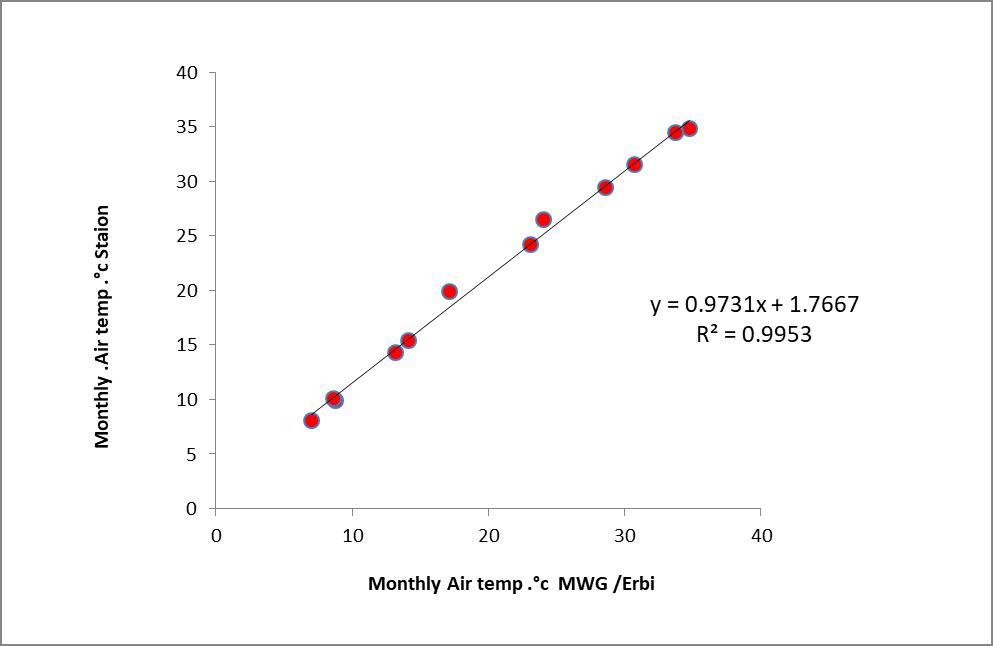Prediction long term Surface Temperature Variation in Kurdistan Region using Meteonorm Weather Generator (MWG)
DOI:
https://doi.org/10.21271/ZJPAS.35.5.4Keywords:
Meteonorm, IPCC, Climate, Kurdistan, Temperature.Abstract
The climate of Kurdistan Region was subjected to many changes that led to a noticeable rise in temperatures. The current study aims to assess the climate of Kurdistan Region- Iraq by using Weather Generator program (MWG). We have chosen two different regions which are Erbil and Duhok governorates. The global climate database (MWG) was run for the three climate scenarios B1, A1B and A2 for 2020, 2050 and 2100. The average temperature was calculated and analyzed for the period (2000-2009) for Erbil and Dohuk governorates. The results have shown that Scenario B1 predicted the lowest rise in temperature compared to Scenario A2 which expected the highest rise in temperature. The predicted temperature of Erbil is higher than Dohuk for the three selected years and scenarios.
References
Abd AlKareem, H. (2016). "Assessing of Climate Change on Iraq using Meteonorm Weather Generator." IOSR Journal of Applied Physics (IOSR-JAP) 8(6): 55-61.
Aizebeokhai, A. P. (2009). "Global warming and climate change: Realities, uncertainties and measures." International journal of physical sciences 4(13): 868-879.
Al-Jumur, S., et al. (2021). "Predicting temperature of Erbil City applying deep learning and neural network." Indonesian Journal of Electrical Engineering and Computer Science 22(2): 944-952.
Boscolo-Galazzo, F., et al. (2018). "Temperature dependency of metabolic rates in the upper ocean: A positive feedback to global climate change?" Global and Planetary Change 170: 201-212.
de Lorenzo, A. and F. Liaño (2017). "High temperatures and nephrology: The climate change problem." Nefrología (English Edition) 37(5): 492-500.
Gasparrini, A., et al. (2015). "Mortality risk attributable to high and low ambient temperature: a multicountry observational study." The lancet 386(9991): 369-375.
Haunschild, R., et al. (2016). "Climate change research in view of bibliometrics." PloS one 11(7): e0160393.
Mangan, S. D. and G. Koçlar Oral (2020). "Impacts of future weather data on the energy performance of buildings in the context of urban geometry." Cogent Engineering 7(1): 1714112.
MUSTAFA, N. F., et al. (2018). "Aridity index based on temperature and rainfall data for Kurdistan region-Iraq." Journal of Duhok University 21(1): 65-80.
Park, K.-J., et al. (2022). "Examining the transition of natural disaster management for climate change." International Journal of Business Continuity and Risk Management 12(2): 116-130.
Remund, J., et al. (2010). The use of Meteonorm weather generator for climate change studies. 10th EMS Annual Meeting.
Robert, M. A., et al. (2019). "Temperature impacts on dengue emergence in the United States: Investigating the role of seasonality and climate change." Epidemics 28: 100344.
TANRIVERDI, C. and B. A. RAGAB "DROUGHT ANALYSIS FOR DUHOK PROVINCE USING STANDARDIZED PRECIPITATION INDEX."
Xu, Y. (2019). "Estimates of changes in surface wind and temperature extremes in southwestern Norway using dynamical downscaling method under future climate." Weather and Climate Extremes 26: 100234.

Downloads
Published
How to Cite
Issue
Section
License
Copyright (c) 2023 Safa Gh. Hameed, Sardar.M.R. K Al-Jumur

This work is licensed under a Creative Commons Attribution 4.0 International License.













